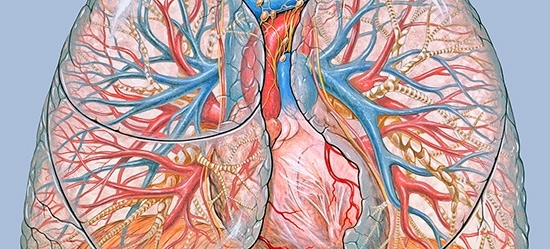

Research findings published in The New England Journal of Medicine illustrate how a key parameter can reduce mortality among patients with acute respiratory distress syndrome (illustration: Wikimedia)
Research findings published in The New England Journal of Medicine illustrate how a key parameter can reduce mortality among patients with acute respiratory distress syndrome.
Research findings published in The New England Journal of Medicine illustrate how a key parameter can reduce mortality among patients with acute respiratory distress syndrome.

Research findings published in The New England Journal of Medicine illustrate how a key parameter can reduce mortality among patients with acute respiratory distress syndrome (illustration: Wikimedia)
By Karina Toledo
Agência FAPESP – A Brazilian study published in The New England Journal of Medicine will foster a worldwide change in the treatment of acute respiratory distress syndrome (ARDS), a life-threatening lung condition that prevents enough oxygen from entering the bloodstream and requires patients to be placed on mechanical ventilation in intensive care units (ICUs).
After analyzing data gathered from 3,562 participants in nine previously reported trials, a group of researchers at the University of São Paulo’s Heart Institute (INCOR-USP) concluded that driving pressure (or lung distending pressure), which corresponds to the pressure difference between inspiration and expiration, is the key parameter for protecting the lungs and increasing the survival rates of patients with ARDS.
“The higher the driving pressure, the greater the risk. The acceptable limit is about 15 cm of water (cmH2O). It used to be believed that the key was to keep maximum end-inspiration pressure below 30 cmH2O, but we showed that this isn’t important,” said Marcelo Amato, Supervisor of INCOR’s Respiratory ICU and coordinator of the research project supported by FAPESP.
ARDS is characterized by inflammation of the lungs that results in fluid accumulation and respiratory insufficiency. It commonly occurs as a complication after abdominal infection, pneumonia, or a severe case of influenza, such as that caused by the H1N1 virus. It also typically occurs in victims of traumatic injury and near drowning, as well as in individuals who inhale large quantities of smoke during fires.
“The main problem is that mechanical ventilation causes additional injury to the lungs, triggering a vicious cycle in which the patient becomes increasingly dependent on the ventilator as the machine exacerbates their respiratory distress,” Amato said.
He explained that damage is done as a result of two factors: the high concentration of inhalable oxygen that must be delivered to keep the patient alive, and the excessive energy and pressure with which air is pumped into the lungs by the ventilator.
“Today we know this was what caused the death of President Tancredo Neves, for example. Following surgery for removal of a bowel tumor, he developed abdominal sepsis and then ARDS. His death was caused by respiratory insufficiency because the standard treatment at that time was aggressive to the lungs,” Amato said.
Paradigm shift
The use of pulmonary physiology principles as a basis for protective mechanical ventilation strategies is a line of research that has been pursued by INCOR’s Respiratory ICU since the late 1980s.
In 1998, a study that was published in The New England Journal of Medicine by the same group showed that personalized ventilation strategies reduced mortality among patients with ARDS from 70% to 40%.
According to that study, many lives would be saved if parameters such as tidal volume (the volume of air inhaled during quiet breathing), plateau pressure and peak pressure were adjusted according to each patient’s individual profile.
According to Carlos Roberto Ribeiro de Carvalho, Full Professor of Pulmonology at the University of São Paulo’s School of Medicine (FMUSP) and co-author of the studies, this treatment protocol changed the application of mechanical ventilation both in Brazil and worldwide.
“Nothing done until then had reduced mortality so drastically in intensive medicine,” Amato said. “This raised a suspicion that the data must be wrong, so a number of trials were performed to confirm the findings.”
Nine of these subsequent studies, which were conducted in the United States, Canada and France, among other countries, were selected to provide data for analysis by the group led by Amato.
“We contacted each of the lead investigators and reviewed the entire database for every single one of those studies. As a result, we had access to the complete dataset for all 3,562 patients,” Amato said.
Using a statistical tool known as multilevel mediation analysis, the group investigated the variables that are likely to play key roles in ARDS mortality, including peak pressure, plateau pressure, mean pressure, tidal volume and respiratory frequency, to determine which factors were most strongly associated with survival.
“Experiments performed at FMUSP’s Experimental Pulmonology Laboratory suggested that driving pressure was the mediator. These studies helped us formulate the hypothesis,” Amato said.
He believes that the discovery will have major practical implications for the critical care of ARDS patients and “should avoid many mistaken bedside decisions in the ICU”.
“The physician often sees peak pressure exceeding 30 cmH20, the classic limit, and thinks immediate action must be taken, whereas in actual fact nothing needs to be done because driving pressure is at a reasonable level. Even more frequently, physicians are reassured because peak pressure is below 30 cmH20 and do nothing, even though driving pressure is high, which is extremely dangerous,” Amato explained.
The article “Driving Pressure and Survival in Acute Respiratory Distress Syndrome” (doi: 10.1056/NEJMsa1410639) can be read by subscribers to The New England Journal of Medicine at www.nejm.org/doi/full/10.1056/NEJMsa1410639.
Republish
The Agency FAPESP licenses news via Creative Commons (CC-BY-NC-ND) so that they can be republished free of charge and in a simple way by other digital or printed vehicles. Agência FAPESP must be credited as the source of the content being republished and the name of the reporter (if any) must be attributed. Using the HMTL button below allows compliance with these rules, detailed in Digital Republishing Policy FAPESP.





